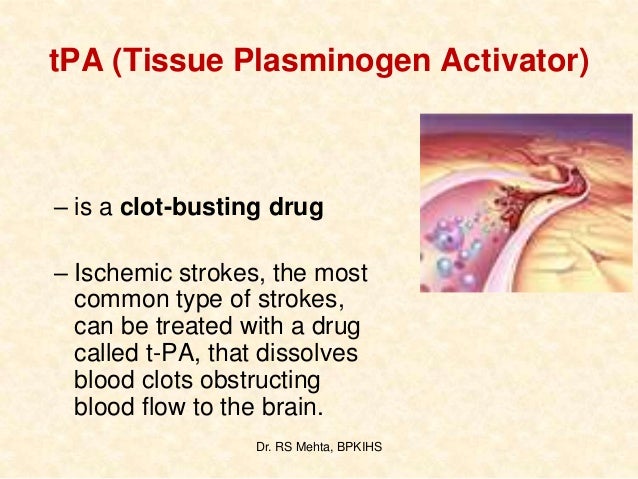Tpa Clot Agent
Posted : admin On 7/15/2022Laboratory Techniques in Fibrinolysis Testing
Recanalization rates with the administration of intravenous tissue plasminogen activator in acute ischemic stroke are low. Adjuvant endovascular techniques that achieve recanalization by direct intra-arterial (IA) delivery of thrombolytics, mechanical clot retrieval, clot aspiration, and stenting may complement intravenous pharmacotherapy. IA thrombolytics can be administered within 6 hours of. All currently approved thrombolytic drugs are biologics, either derived from Streptococcus species, or, more recently, using recombinant biotechnology whereby tPA is manufactured using cell culture, resulting in a recombinant tissue plasminogen activator or rtPA. Tissue plasminogen activator (tPA) is a thrombolytic agent that breaks down blood clots to restore blood flow to the ischemic region of the brain and is the only FDA-approved drug available to treat ischemic stroke. From: Estrogen Effects on Traumatic Brain Injury, 2015. Standard Treatment: tPA to Dissolve the Blood Clot The technique for treating blood clots causing stroke is called intravenous thrombolysis—in lay terms, “clot-busting.” Thrombolysis is the combination of two Greek words, “thrombus,” meaning blood clot, and “lysis,” meaning to dissolve or break apart.

Tpa Clot Agent Login
Wayne L. Chandler MD, inTransfusion Medicine and Hemostasis (Third Edition), 2019
Tissue Plasminogen Activator
t-PA exists in two forms in plasma: (1) free t-PA capable of binding to and activating plasminogen, and (2) t-PA/PAI-1 complex an inactive form of inhibited t-PA. t-PA may be measured by either functional or antigenic assays. t-PA activity measures only the free, functional form of t-PA. t-PA in complex with PAI-1 and other inhibitors is not measured. Free t-PA in blood must be stabilized by drawing the sample into an acidified citrate solution to prevent inactivation of free t-PA by active PAI-1 in blood. t-PA activity is measured by capturing t-PA on a microtiter plate using monoclonal antibodies, washing off PAI-1 and antiplasmin inhibitors, and then measuring activity by adding plasminogen, a fibrinlike activator that enhances plasminogen activation by t-PA and a plasmin sensitive chromogenic substrate. t-PA converts plasminogen to plasmin, and the plasmin cleaves the substrate. Total t-PA antigen representing both active and inactive fractions can be measured using an enzyme immunoassay.
Tpa Clot Buster
Read full chapter